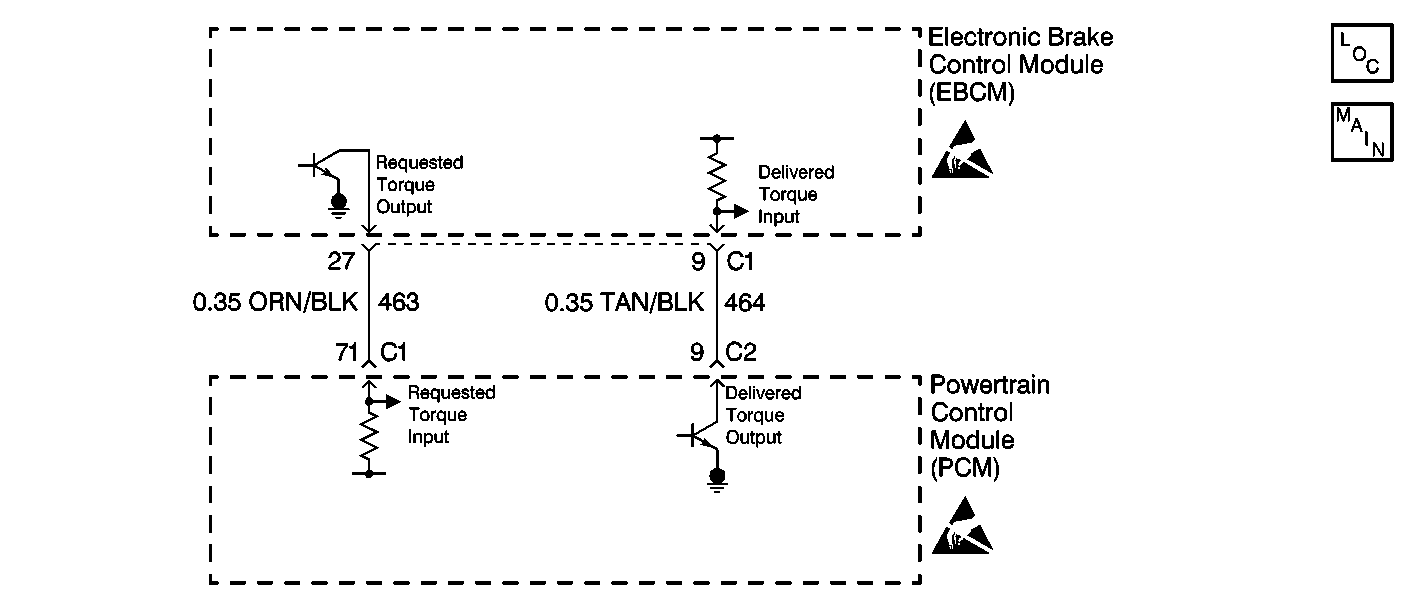
Circuit Description
Traction Control is simultaneously controlled by the EBCM and the ECM. The EBCM sends a requested torque message via a Pulse Width Modulated (PWM) signal to the ECM requesting a desired engine torque level for proper Traction Control system operation. The PCM supplies the pull up voltage.
Conditions for Setting the DTC
| • | If a defective requested torque signal is detected by the PCM, a message is broadcasted back to the EBCM via class 2. |
| • | DTC C0241 can be set anytime when ignition voltage is present and the EBCM detects the first class 2 message of a defective requested torque signal from the PCM. |
Action Taken When the DTC Sets
| • | A malfunction DTC is stored. |
| • | The TCS is disabled. |
| • | The TRAC OFF indicator is turned on. The ABS remains functional. |
Conditions for Clearing the DTC
| • | Condition for DTC is no longer present and scan tool clear DTC function is used. |
| • | 100 ignition cycles have passed with no DTC(s) detected. |
Diagnostic Aids
| • | It is very important that a thorough inspection of the wiring and connectors be performed. Failure to carefully and fully inspect wiring and connectors may result in misdiagnosis, causing part replacement with reappearance of the malfunction. |
| • | If an intermittent malfunction exists, refer to Checking Aftermarket Accessories in Wiring Systems. |
| • | Possible causes for DTC C0241 to set: |
| - | Open in the circuit 463. |
| - | Circuit 463 shorted to ground or voltage. |
| - | Communication problem. |
| - | Circuit 463 has a wiring problem, terminal corrosion, or poor connections. |
| - | PCM not receiving information from the EBCM. |
Test Description
The numbers below refer to step numbers on the diagnostic table.
-
Checks for the proper requested torque value received at the PCM. This value is in percent of torque.
-
Checks for the proper requested torque value sent from the EBCM. This value is in newton meters of torque.
-
Checks for the presence of a pull-up voltage from the PCM.
Step | Action | Value(s) | Yes | No |
|---|---|---|---|---|
1 | Was the Diagnostic System Check performed? | -- | ||
2 | Check that ground, G101 and G106 is clean, tight and free of damage. Refer to Power and Grounding Components in Wiring Systems. Were any loose, damaged, or corroded grounds found? | -- | ||
3 | Repair ground as necessary. Refer to Wiring Repairs in Wiring Systems. Is the repair complete? | -- | -- | |
Is the desired torque within the range specified in the value(s) column? | 80-95 % | |||
Is the requested torque within the range specified in the value(s) column? | 0 N·m | |||
6 | Replace the EBCM. Refer to Electronic Brake Control Module Replacement . Is the replacement complete? | -- | -- | |
Is the voltage within the range specified in the value(s) column? | 4.5-5.5 V | |||
8 |
Is the voltage within the range specified in the value(s) column? | Greater than 1V | ||
9 | Repair CKT 463 for a short to voltage. Refer to Wiring Repairs in Wiring Systems. Is the repair complete? | -- | -- | |
10 |
Is the resistance within the range specified in the value(s) column? | OL (infinite) | ||
11 | Repair CKT 463 for a short to ground. Refer to Wiring Repairs in Wiring Systems. Is the repair complete? | -- | -- | |
12 |
Is the resistance within the range specified in the value(s) column? | 0-2 ohms | ||
13 | Suspect PCM. Refer to Powertrain On Board Diagnostic (OBD) System Check in Engine Controls. Is the Repair complete? | -- | -- | |
14 | Repair CKT 463 for an open. Refer to Wiring Repairs in Wiring Systems. Is the repair complete? | -- | -- |
